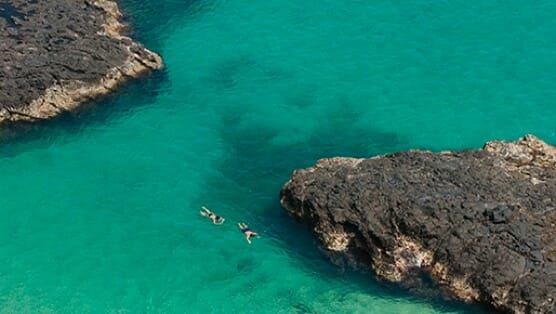The Battle of Brazil’s Most Beautiful Destinations

Brazil is a nation with an embarrassment of beautiful riches, but the title for most stunning place can be narrowed down to either Fernando de Noronha (pictured above) or Lençóis Maranhenses.
More than 200 miles from the mainland, Fernando de Noronha is a 21-island archipelago formed by the peaks of the Southern Atlantic ridge rising 12,000 feet from the ocean floor. Visitors stay on the 10-square-mile main island, with planes arriving from Natal and Recife on the mainland.
If Fernando de Noronha is like visiting a storybook paradise, Lençóis Maranhenses is like visiting another planet. Shifting white sand dunes fill the 600-square-mile national park, and the rainy season leaves behind countless freshwater lagoons. The term Lençóis means “linen,” which aptly characterizes the park’s look of ruffled white bed sheets. Most people stay in Barreirinhas, a small town outside the park, and arrive via São Luis, a colonial city founded by the French. Located in northeast Brazil, both Fernando de Noronha and Lençóis Maranhenses are UNESCO World Heritage Sites.
What Makes Them Special
Fernando de Noronha
For centuries, Fernando de Noronha was an island where people sought escape, but not in the sense one might expect. Brazil’s first national marine park was formerly a political prison. Changes opened the tourism door several decades ago, though restrictions keep the masses at bay. Only people born on the island can live there, and tourists—limited to several 100 at any one time—must pay a daily environmental tax. The island also forbids new construction on its beaches, business chains and Jayoncé-type vacation palaces. In other words, Noronha is paradise found with wide sandy beaches that never met a condominium. While Charles Darwin visited in 1832, Amerigo Vespucci set foot on Noronha three centuries earlier, and his dramatic account of the island possibly inspired the setting for Thomas More’s novel Utopia.
Lençóis Maranhenses
Though it evokes images of a desert mirage with a 1,000 oases, Lençóis Maranhenses’ ecological dreamland is technically not a desert. By definition, a desert should average less than 10 inches of rainfall per year, and Lençóis receives about 50 inches thanks to the neighboring Amazon Basin. As to the magical look, the Parnaíba and Preguiças rivers carry sand from the interior to the Atlantic, and ocean currents and powerful northeasterly winds push the sand back inland up to 30 miles. The result is a series of dunes that can reach more than 100 feet in height. Meanwhile, the rainy season (December to April) produces crescent-shaped freshwater lagoons, and an underlying layer of rock keeps the water largely intact through the fall months. At full size, the bodies of water can be hundreds of feet long and 10-feet deep. The 2005 Brazilian film The House of Sand, winner of a Sundance Film Festival award, was filmed in Lençóis.

Lençóis Maranhenses Photo by Ricardo Rollo
What to See
-

-

-

-

-

-

-

-

-

-

-

-

-

-

-

-

-

-

-

-

-

-

-

-

-

-

-

-

-

-

-

-

-

-

-

-

-

-

-

-









































